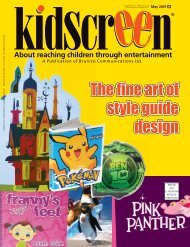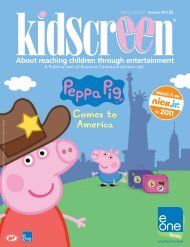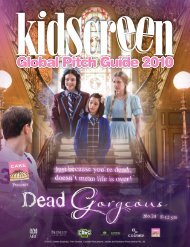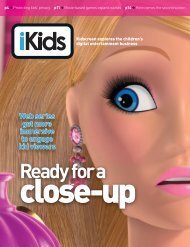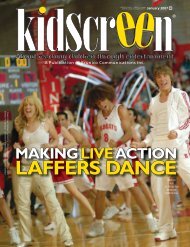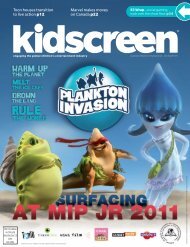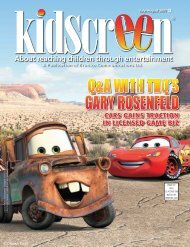rs ANIMATION SECIVRES CONTENTS - Kidscreen
rs ANIMATION SECIVRES CONTENTS - Kidscreen
rs ANIMATION SECIVRES CONTENTS - Kidscreen
You also want an ePaper? Increase the reach of your titles
YUMPU automatically turns print PDFs into web optimized ePapers that Google loves.
Crossingham and Wood agree that the connection between<br />
stop motion and the audience is almost impossible to replicate.<br />
“People know when they look at something that existed,” Crossingham<br />
contends. “There is an unde<strong>rs</strong>tanding that what they are<br />
seeing is tangible and that it really does exist.”<br />
Arianne Sutner is a producer for Portland, Oregon-based<br />
animation house Laika. The studio released stop-motion animated<br />
hit Coraline in 2009 and Sutner’s most recent credit<br />
is as a producer for ParaNorman, which rolled out worldwide<br />
in August. The fi lm has grossed approximately US$95 million<br />
globally to date.<br />
“It’s always been around and it’s always been appreciated<br />
because it’s a beautiful art form,” she says. “I’ve been working in<br />
stop motion for 23 yea<strong>rs</strong>; I don’t necessarily think the audience<br />
has an ave<strong>rs</strong>ion to CGI so much as stop motion is just an artform<br />
people appreciate.”<br />
OUTSTANDING<br />
The tactile feel and emotional payoff that many associate with<br />
the animation style is not only the result of putting real materials<br />
on-screen; it is also the result of a highly collaborative process<br />
that by its very nature is inclusive in ways that other animation<br />
styles are not.<br />
“The actual animation itself is only one tiny part,” explains<br />
Crossingham. “It is really multi-disciplinary. We don’t say you<br />
have to study a particular thing; most of the people who are valuable<br />
really come out of left fi eld.”<br />
Unlike other styles, where computer technical skill is paramount,<br />
stop motion pulls skills from a variety of disciplines like<br />
live theater and live-action productions. Additionally, the fi lming<br />
process dictates that many different elements of the production<br />
have to come together in a more holistic way than they<br />
do on a 2D or CGI project. Stop motion is not a linear process.<br />
“When we launch a shot, every department has to be on<br />
set,” says Sandell. “The set dresse<strong>rs</strong>, animato<strong>rs</strong>, rigge<strong>rs</strong>, DP<br />
and director all have to come together in an amazing way to<br />
get the shot. There is nothing more satisfying<br />
than seeing all these disciplines<br />
come together.”<br />
Channel 5 in the UK recently commissioned<br />
a second season of Manchester,<br />
England-based Komixx Entertainment’s<br />
preschool production Toby’s Travelling<br />
Circus. When produce<strong>rs</strong> initially set out<br />
to make the 52 x 10-minute series, the<br />
option to produce it in a cheaper format<br />
was tempting.<br />
“We could have gone the CGI route,”<br />
says Andrew Cole-Bulgin, joint CEO of the<br />
company. “We had a number of companies<br />
approaching us with the idea of doing<br />
a CGI stop-frame lookalike.”<br />
The ability to shave US$2 to US$3<br />
million off a US$7-million budget was<br />
tempting, but ultimately the decision to<br />
stick with the original animation plan has paid off in good ratings,<br />
a unique fi nished product and a greenlight for a second season.<br />
“Kids are a brilliant audience,” Cole-Bulgin explains. “They are<br />
unforgiving, and if you put rubbish in front of them they will turn<br />
off the TV right away.”<br />
The series tells the tale of Toby, a seven-year-old boy who<br />
runs his own circus. Complete with a visually arresting cast of<br />
carousels, rocket rides, acrobats and clowns, the produce<strong>rs</strong> believe<br />
the show’s success is due in part to the fact that it stands<br />
out visually from other preschool programs.<br />
“We had to be slightly crazy to do it in stop motion,” says<br />
Richard Randolph, head of production and creative director at<br />
Komixx Entertainment. “It was quite a challenge, but when I saw<br />
what it looked like with the actual puppets it was fantastic. The<br />
way the movement translates is stunning.”<br />
NEW TECHNIQUES<br />
Like all other forms of production, the digital revolution changed<br />
the way stop motion is produced. “The biggest technological<br />
advance in recent history is the use of shooting on digital,” says<br />
Crossingham. “Now we are able to see what we are doing while<br />
we are doing it, instead of having to wait.”<br />
However, the ascension of another digital byproduct, HD, has<br />
also made it harder to hide the little imperfections that crop up<br />
during production. The attention to detail required to scrub out<br />
those small fl aws has added hou<strong>rs</strong> to production schedules,<br />
which doesn’t exactly help the bottom line.<br />
“It’s a double-edged sword,” says Crossingham. “Before, you<br />
didn’t have to pay so much attention to detail. And now we have<br />
to be very careful about what we present to the world.”<br />
Another key innovation has been the use of 3D printing technology,<br />
also known as rapid prototyping, to improve the manipulation<br />
of character faces.<br />
“We started using 3D printing technology for Coraline,” says<br />
Sandell. “Before, we used to use tiny gea<strong>rs</strong> and joints in faces but<br />
found that we could achieve the same thing through 3D printing.”<br />
Ragdoll Productions’ The Adventures of Abney & Teal<br />
KIDSCREEN’S <strong>ANIMATION</strong> SERVICES ISSUE 2012 25








